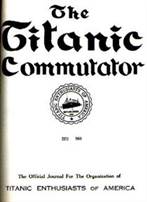IN THIS ISSUE
Second issue for the 2014 membership year
In this second quarter issue, George Rosenshine’s Final Voyage is an exclusive, never before published account. Janet Ripin’s great uncle, George Rosenshine, a 1st class passenger on Titanic, mailed postcards to his three nieces during an around-the-world trip before he boarded Titanic. The postcards survived all these years due to the sentimental and saving nature of Janet’s mother, Viola, who lived with her Uncle George from 1905-1910. Viola kept the cards among other old family letters and mementoes in a large steamer trunk in the attic of her childhood home and Janet came into their possession upon her mother’s death in 1949. George’s last extant postcard is dated March 15, 1912, from ltaly. One month later, on April 15, 1912, the forty-six year-old bachelor’s fully dressed, frozen body, complete with wristwatch, was floating, buoyed by a life preserver in the North Atlantic’s frigid 28 degree water. Decades later, Janet Ripin contacted the THS and donated the collection.
Just about everyone agrees that the Titanic disaster was the result of a collision between the liner and an iceberg. There is much debate about what actually happened that caused a technological marvel like Titanic to fall so readily to a brush with a floating piece of ice. Beginning shortly after news flashed out about the disaster and continuing to modern day, an endless procession of pundits has offered up various theories about what happened. In Parks Stephenson’s riveting article, Why Did Titanic Sink?, he describes what he has learned and how he applied that knowledge to contribute to what we can know about how and why Titanic sank.
Titanic, an extract from the unpublished autobiography of Lt. Colonel Frank Bustard, O.B.E, is an intriguing look into the past. Mr. Bustard was 26 at the time of the Titanic disaster and was in his eighties when he wrote his autobiography. “…and the sole surviving executive of the old White Star Line with which I served for 32 years in close personal contact at all times with both Mr. Ismay and for Harold A. Sanderson.” Being there as Mr. Bustard was and observing the human side of Mr. Ismay provides an insight unknown to most.
James Clinch Smith, a 1st class passenger on Titanic died in the sinking. Coincidentally, his life prior to his final voyage home appeared to be frenzied. The Denver Post, August 6, 1911 published a story: Paris, July 29 “Is Mr. James Clinch Smith, American multi-millionaire and brother-in-law of the late Stanford White, qualifying as a second Man Without a Country? A record of his harrowing adventures during the past ten years shows many similarities between him and Mr. Edward Everett Hale’s ever moving hero. Mr. Smith was at one time a New York financier and was born plain Smith at Smithtown, Long Island, the place from which all the American Smiths originally came. He married a society beauty who evolved an ambition to become the feminine Maecenus (look it up in any encyclopedia under “Horace”). Consequently Mr. Smith has for a decade been an animated ping-pong ball between an overplus of uxoriously encouraged harmonies in his Paris home and an adverse natural fate which, every time he tries to escape to his native shores, either thrusts him back before he gets there, or makes it so unpleasant for him when he does that even home seems like Paradise, and the colonies of musicians the heavenly choirs.”
The handsome cast bronze maker’s plate which at one time had been attached to a bank vault door made by Milner & Co. based in Liverpool and London has been in some storied locations. Martyn Harbott, a bank clerk and THS member, noted it on Titanic’s Purser’s safe at the bottom of the Atlantic, at Belfast City Hall, another in 30 James Street and one from the former London and Southwestern Bank where he was employed. When the bank closed, its medallion was donated to the Titanic Historical Society. Its beauty is from a different time and Harbott’s story of the buildings, working conditions and the surrounding area is roughly contemporary with the Olympic, Titanic and Britannic era. More than anything, their description shows how working in a bank has changed!
CONTENTS
George Rosenshine’s Final Voyage
By Janet Ripin
George Rosenshine’s Final Voyage as Seen in His Postcards
Courtesy of Janet Ripin
Titanic: Extract from the Unpublished Biography of Lt. Col. Frank Bustard, O.B.E.
By Lt. Col. Frank Bustard, O.B.E.
Why Did Titanic Sink?
By Parks Stephenson
Titanic’s Safes – Bank Clerk Experiences from a Past Era
By Martyn Harbott
Why Mr. James Clinch Smith Left Home
The Denver Post
Memorial Garden and Walkway Dedication
Memorial Garden and Walkway Donors
SEA POSTE
Was there a jeweled copy of the Rubaiyat on board Titanic or just a rumor?; Information on a Titanic poster; Margaret Brown’s signature in old book authentic?; Curious if Edwyna West is living, sister of Barbara West; Is a silk weaving an image of Captain Smith? White Star Burgee flies for first time at 30 James St. since 1934.
BOOK NOTES
The Unseen Britannic: The Ship in Rare Illustrations by Simon Mills reviewed by Paul Louden-Brown.
FRONT COVER: The only known photo of George Rosenshine from a family portrait. Courtesy Janet Ripin/THS collection
BACK COVER: Gertrude Thorne and George Rosenshine sailed on the maiden voyage of the Shinyo Maru from San Francisco as they headed toward Honolulu, Hawaii. United States Navy Archive





